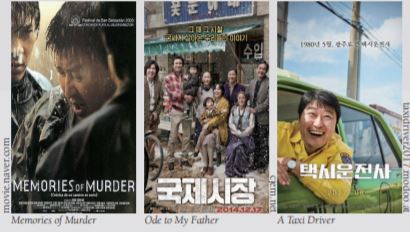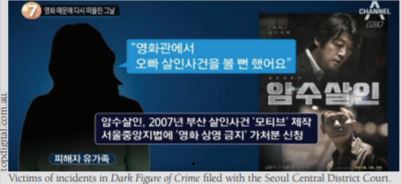Last September, a real prime suspect, who was the focus of the movie, Memories of Murder, which was released in 2003, was finally identified. Authorities failed to arrest the criminal years ago due to several limitations until 2019, but citizens’ constant concerns finally helped catch the suspect. After this remarkable achievement, the positive functions of movies, especially based on true stories, are being focused on. Therefore, the Sungkyun Times (SKT) is now going to find out the strengths and weaknesses of the true-story movies and how they should move forward.
The Strengths of True-story Movies
True-story movies, which are created based on true stories, are also known as “faction”, a word consisting of fact and fiction. There are three types of true-story movie. Historical films use historical figures or events; human films use a specific person that has lived or is living in modern society; social impact films use a tragic event or a crime as the source of the films. Here, the social impact film which has been issued because of the Memories of Murder is going to be discussed mainly.
Sense of Immersion Leading to Success in the Box-office
The narrative in the true-story movie is based on actual incidents so that it could be more organized than fiction. It also helps audiences to be absorbed in the movies when they recognize that the movie they are watching is based on a real story. Audiences think that the story in the film is something that they can experience, so they easily identify with the story in their real life. Grounded on these characteristics, lots of true-story movies have succeeded in the box office since the 2000s. Among the 26 movies which hit the 10 million viewer mark in Korea, nine movies are true-story movies, including Ode to My Father and A Taxi Driver. That is, the true-story movie is an appealing genre in both the narrative aspect and sense of immersion.

Arousing the Public Interest
A film, especially for the social impact film, can play a role in journalism, and it is called movie journalism. Films lead audiences to look at the reality around them in a straightforward way and participate in society more actively by adapting and reproducing the real story. They can constantly make an issue of social problems, which otherwise would be buried quickly in the publics’ memory. The sentences imposed on real criminals of the movie Silenced, for example, ended in probation in 2005. After the film was released in 2011, however, it aroused public outrage. Thus, a reinvestigation was made and the school was closed. Likewise, films can continuously evoke social problems that are not solved or reveal the truth (that people have the right to know about) to the public.
The Weaknesses of the True-story Movies
The Vulnerable Protection of the Place or Person in Film
In the case of true-story movies, information about the background of places or related people is easy to spread on the internet. Especially for the movies dealing with the negative incidents, it easy to arouse a reckless criticism or stereotype of them. Nevertheless, there is no clear way to prevent this from happening in terms of film production. If the incidents in the film became public and put out to the media, related people can be traumatized, and their right to be forgotten is not guaranteed. The bereaved families of the victims of incidents dealt with in Dark Figure of Crime filed with the Seoul Central District Court for the suspension of the screening. They claimed that there was no agreement from the families and the film’s similarity to the actual events was too close.
The Possibility of Copycat Crimes
The true-story films, which are more realistic, can cause copycat crimes by stimulating copycat psychology. Lots of true-story movies depict the process of crimes or crime scenes in detail, for more reality in the film. The more the audiences feel the realism and immerse themselves in the film, the more the possibility of success a film has. In response, more films are now depicting more details. Moreover, if there is a narrative of the criminal in the course of a crime, audiences identify criminals with audiences themselves more easily. Even more, if the crimes are shown as thrilling or interesting things, copycat psychology grows more. The movie Friend which is based on the experience of the director, for example, became the motive for a real crime. One high school student watched this film about 40 times, prepared the crime, and stabbed his friend to death. As a result, true-story movies that deal with the actual crime can be imitated or referred to other crimes, as well as the motives for the crime.

Way to Move Forward for True-story Movies
Cultivating the Audiences’ Film Literacy
Film literacy indicates the ability of the viewer to understand and analyze the film through their own initiative, not just by accepting all the things in the film. This is the ability to understand how films are conveying messages, by learning the overall constitution, contents, and effects of films. In addition to acquiring knowledge about the movie, by making its film, one can develop the ability to read the film. Recognizing the importance of film literacy, the Ministry of Education designated 10 elementary schools, three middle schools, and two high schools as schools that would teach media literacy policy studies. The students in the schools take most of the classes, which include media literacy education, not in the form of a special class held once or twice in a year. In summary, audiences have to focus on the messages beyond the surface of the film by reading and understanding it.
Regulation on the Degree of the Reflection
Between the issue of ensuring the autonomy of art and the influence of art, enough discussion on the extent to which the details of the crime should be reflected in true-story movies should take place. Outlaws, a film about the gangs in Garibong-dong, released in 2017, was rated R so that the under-aged cannot watch it for its violence, even though the real crimes were refined and reduced. Thus, social concern and co-ordination with filmmakers about the range of the depiction of a real story are needed.
A film is one of the most public-friendly mediums of media, and therefore the most influential form of media as well. Enough discussion for how much detail should be incorporated into the true-story films is still needed, but, surely, it has to move to the way of maximizing the strengths of true-story films.
